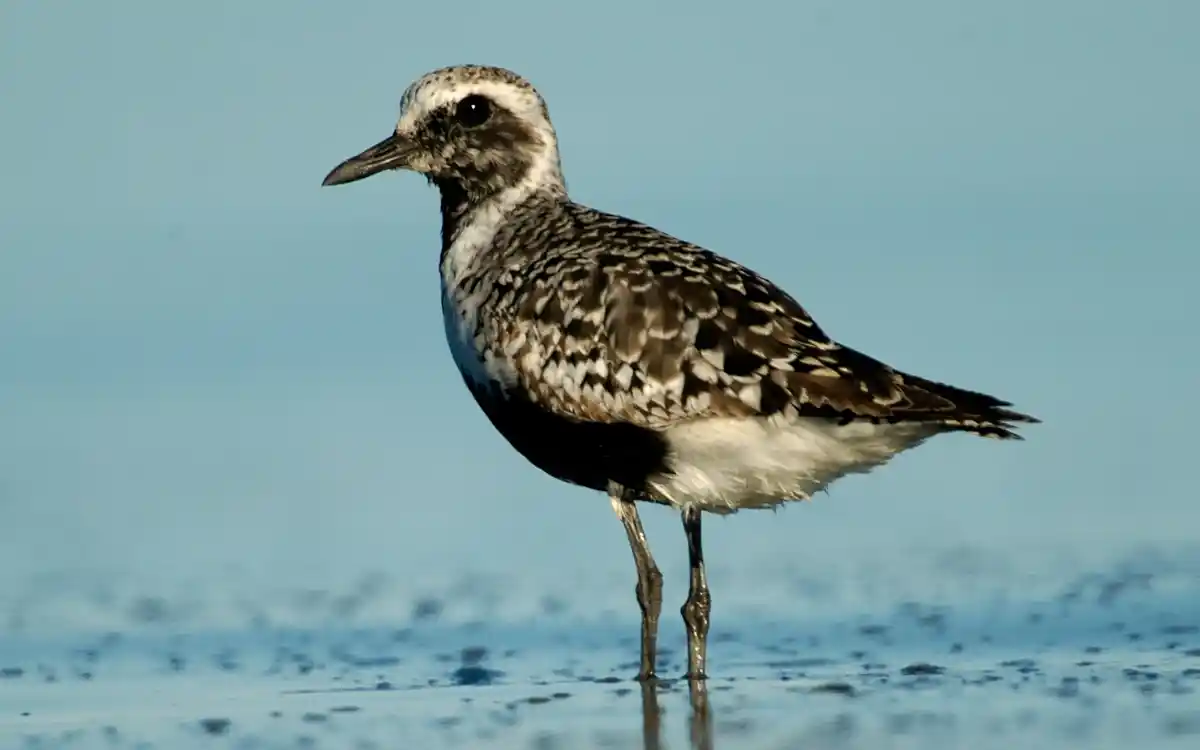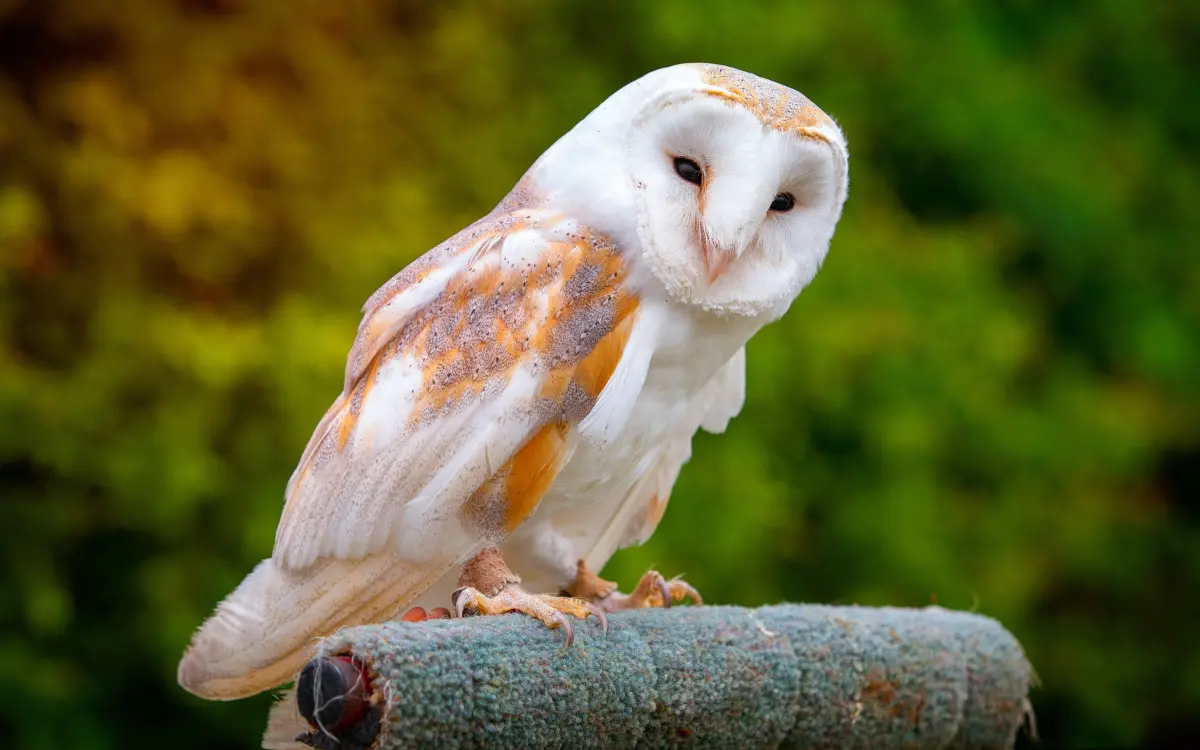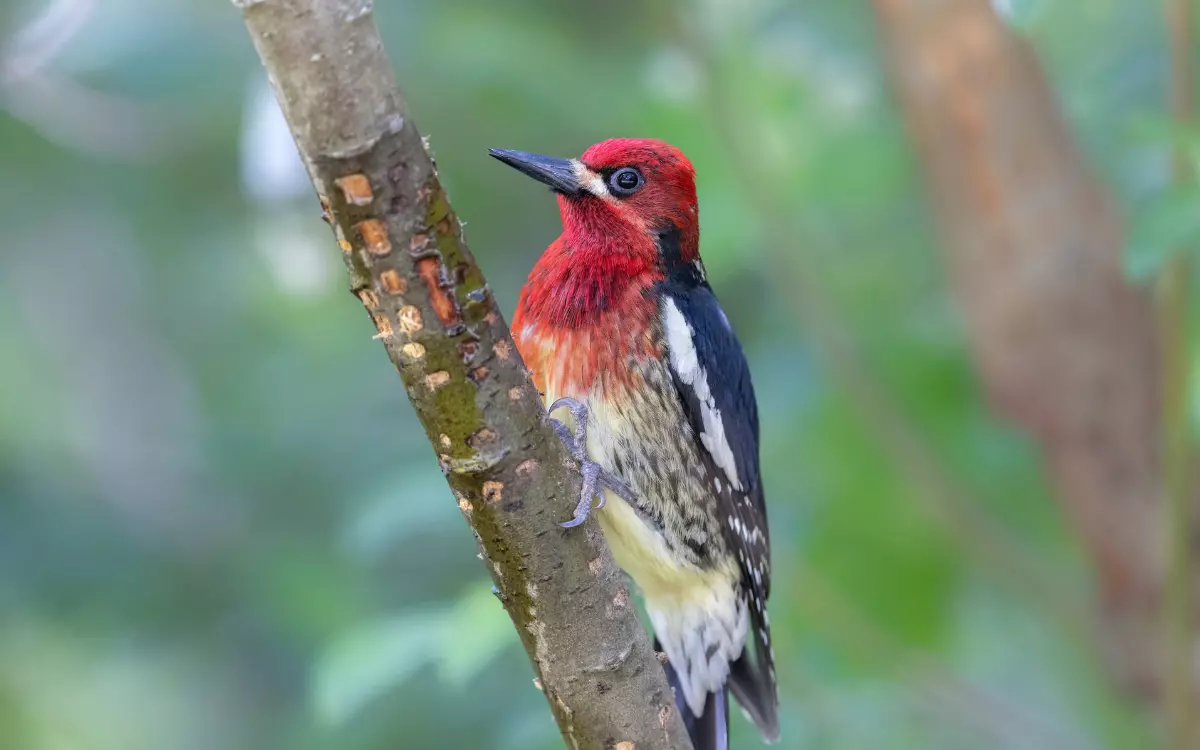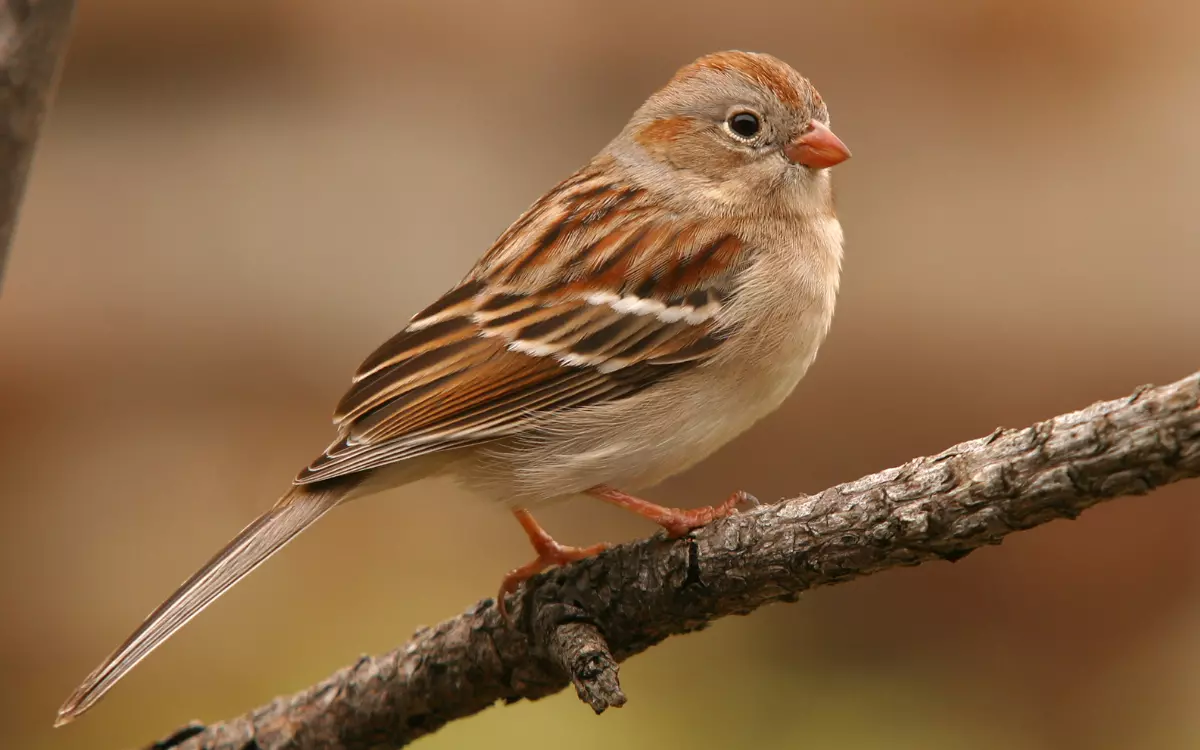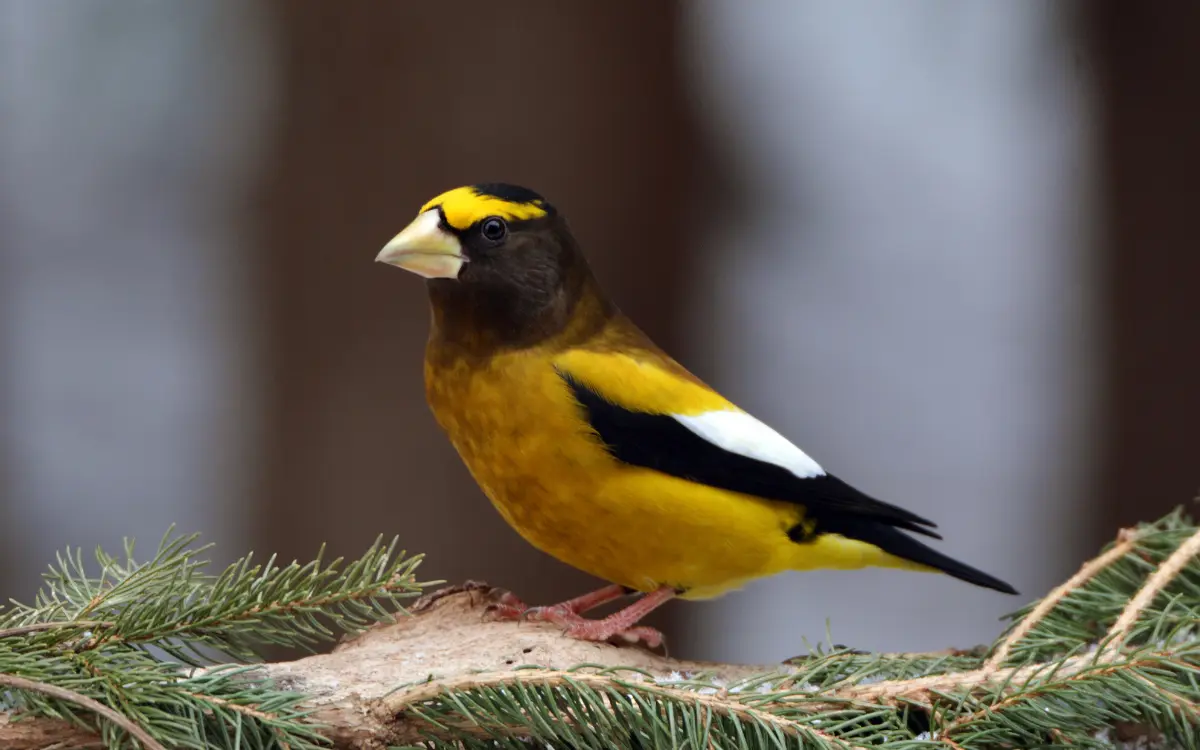31 Louisiana Winter Birds To Explore
Louisiana winter offers a variety of coloring birds during the winter months, from colorful songbirds to powerful birds of prey.
You can explore all the bird in this list that help you know more about them.
All 31 winter birds with their information:
1. Mallard – (Anas platyrhynchos)
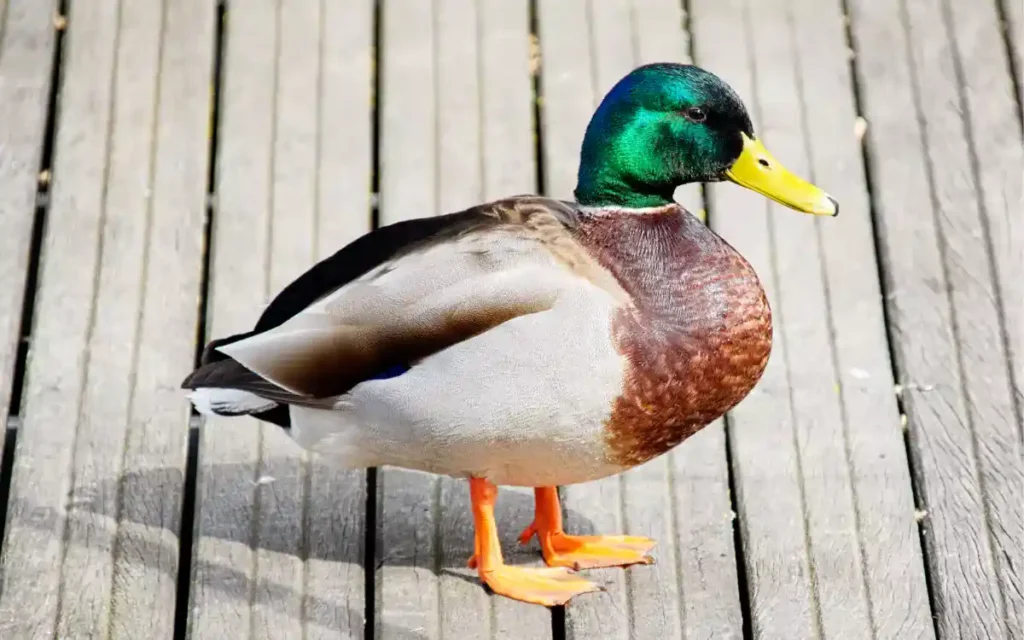
- Kingdom: Animalia
- Phylum: Chordata
- Class: Aves
- Order: Anseriformes
- Family: Anatidae
- Genus: Anas
- Species: Anas platyrhynchos
Mallards are ducks with males showing bright green heads and yellow bills, and females in mottled brown. They are often seen in parks and lakes. Mallards can live in both wild and city areas. Some fly south for winter, while others stay all year.
They eat plants, seeds, and small water creatures. They make nests on the ground near water, using grass and feathers. Each year, a female usually lays about 8 to 13 eggs. They can live 5 to 10 years, but many face dangers like predators.
- Length: 20-26 in (50-65 cm)
- Weight: 1.5-3.5 lb (0.7-1.6 kg)
- Wingspan: 32-39 in (81-98 cm)
2.Canvasback – (Aythya valisineria):
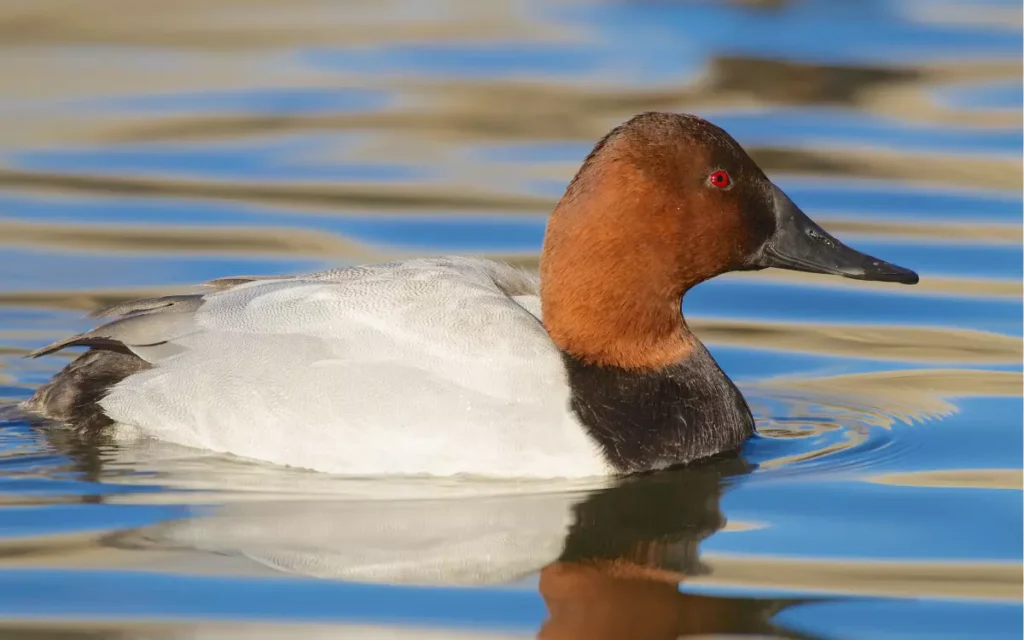
- Kingdom: Animalia
- Phylum: Chordata
- Class: Aves
- Order: Anseriformes
- Family: Anatidae
- Genus: Aythya
- Species: Aythya valisineria
Canvasbacks are ducks with sleek bodies and long black bills. Males have redheads and black chests, while females are brown. They live in lakes and rivers. They migrate, traveling north to breed in summer and south in winter.
They eat water plants and small animals like insects and shellfish. They make nests from plants in marshy areas near water. Females lay about 5 to 11 eggs each year. They can live 5 to 10 years but face threats like loss of habitat and hunting.
- Length: 20-26 in (50-65 cm)
- Weight: 1.5-3.5 lb (0.7-1.6 kg)
- Wingspan: 32-39 in (81-98 cm)
3. Northern Pintail – (Anas acuta)
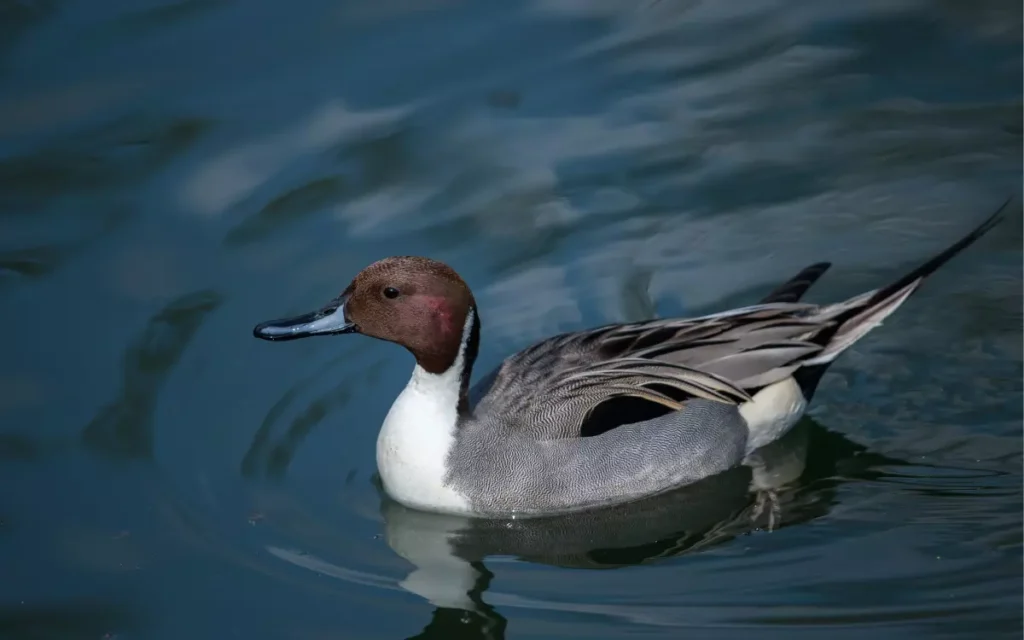
- Kingdom: Animalia
- Phylum: Chordata
- Class: Aves
- Order: Anseriformes
- Family: Anatidae
- Genus: Anas
- Species: Anas acuta
Northern Pintails are slender ducks with long, pointed tails. Males have white breasts and chocolate-brown heads, and females are mottled brown. They frequent wetlands and lakes.
Pintails travel great distances, migrating from northern breeding grounds to warmer southern areas for winter.
Their diet consists of aquatic plants and seeds, and they also eat insects and crustaceans during breeding.They nest on the ground in open areas, using grass to line their nests.Each year, females lay about 7 to 9 eggs.Typically, Northern Pintails live for about 4 to 5 years in the wild.
- Length: 23-30 in (58.5-76 cm)
- Weight: 1-3 lb (454-1362 g)
- Wingspan: 32-39 in (81-98 cm)
4. Green-winged Teal – (Anas crecca)
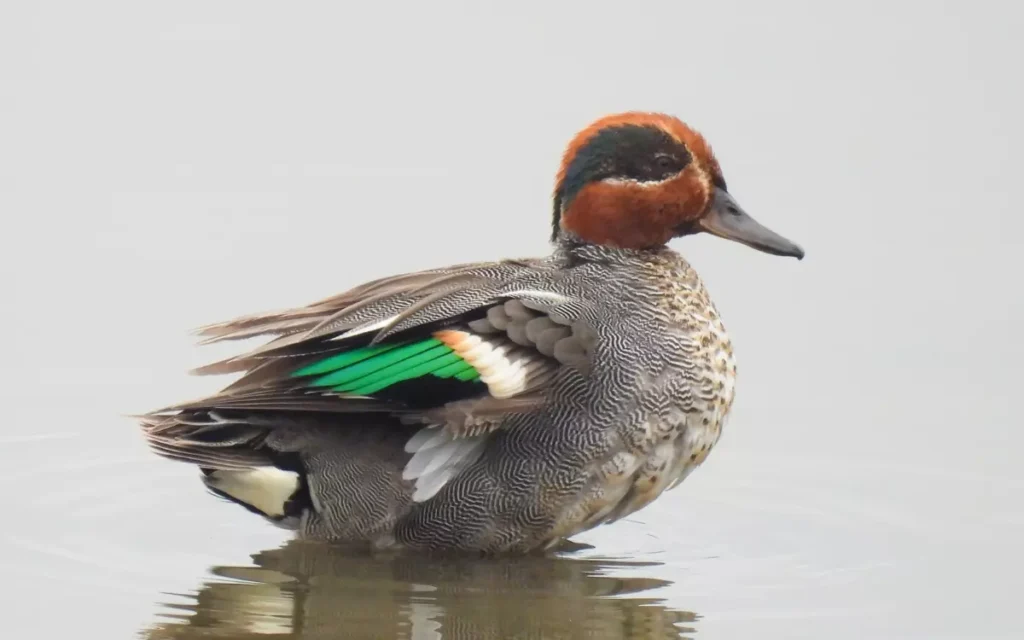
- Kingdom: Animalia
- Phylum: Chordata
- Class: Aves
- Order: Anseriformes
- Family: Anatidae
- Genus: Anas
- Species: Anas crecca
Green-winged Teals are the smallest ducks in North America, with males featuring a chestnut head and a green eye patch, and females in mottled brown. They are commonly found in shallow ponds and marshes.These ducks are highly migratory, traveling long distances between their breeding areas in the north and wintering spots in the south.
They primarily eat seeds and aquatic invertebrates, foraging in shallow waters.Green-winged Teals build their nests on the ground, hidden in dense marsh vegetation.Each year, females lay about 6 to 18 eggs, depending on conditions.In the wild, their lifespan is typically around 10 to 20 years, but survival can vary based on environmental factors.
- Length: 12.2-15.3 in (31-39 cm)
- Weight: 12.3-16.9 oz (350-480 g)
- Wingspan: 20.5-23.2 in (52-59 cm)
5. Blue-winged Teal – (Anas discors)
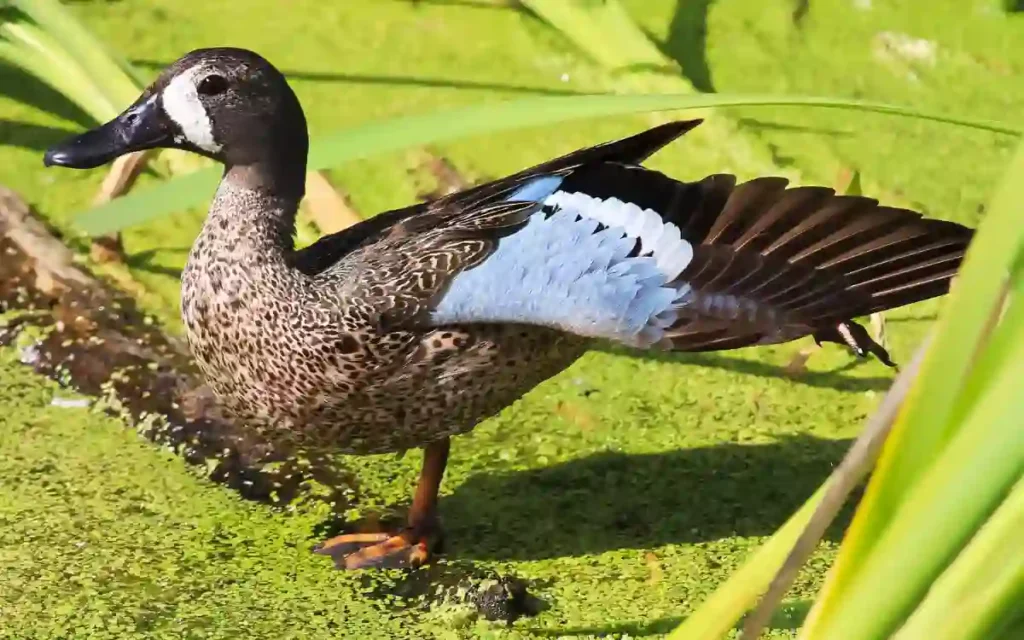
- Kingdom: Animalia
- Phylum: Chordata
- Class: Aves
- Order: Anseriformes
- Family: Anatidae
- Genus: Spatula
- Species: Anas discors
Blue-winged Teals are small ducks with bold white crescents on their faces. Males have gray bodies and blue patches on their wings, while females are brown with less distinct markings. They are often seen in marshes and shallow ponds.These ducks are long-distance migrants, traveling from North American breeding sites to as far south as South America for winter.
They feed on aquatic plants, seeds, and small invertebrates, dabbling at the water’s surface.They nest on the ground in dense vegetation, sometimes far from water.Females typically lay 9 to 12 eggs each breeding season.Blue-winged Teals have a lifespan of about 10 years in the wild, though many face challenges like predation and habitat loss.
- Length: 14.2-16.1 in (36-41 cm)
- Weight: 8.1-19.2 oz (230-545 g)
- Wingspan: 22.1-24.4 in (56-62 cm)
6. American Wigeon – (Mareca americana)
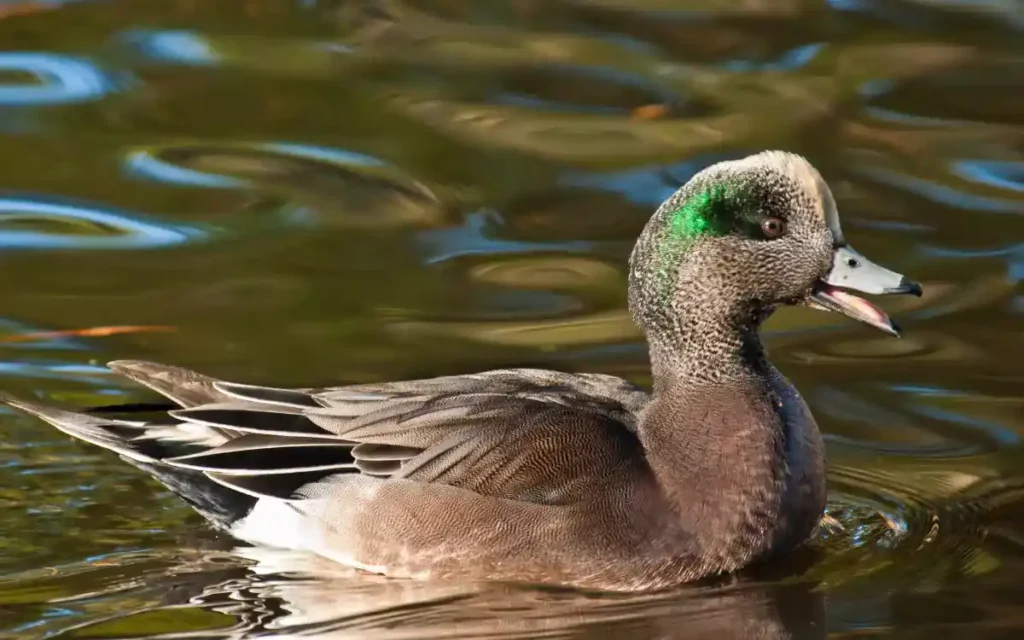
- Kingdom: Animalia
- Phylum: Chordata
- Class: Aves
- Order: Anseriformes
- Family: Anatidae
- Genus: Mareca
- Species: Mareca americana
American Wigeons are medium-sized ducks with males showcasing a white forehead and green stripe running from the eye to the back of the neck, and females are more subdued with speckled brown plumage. They can be spotted in wetlands and open waters.
Known for their long migratory habits, they travel from North American breeding grounds to winter in warmer southern areas.They feed primarily on aquatic plants, grasses, and occasionally insects, which they often snatch from other ducks.
Nests are made on the ground, hidden in thick vegetation near water bodies.Females lay about 6 to 12 eggs each breeding season.In the wild, their lifespan averages around 2 to 3 years, although some can live longer under optimal conditions.
- Length: 16.5-23.2 in (42-59 cm)
- Weight: 19.1-46.9 oz (540-1330 g)
- Wingspan: 33.1 in (84 cm)
7. Redhead – (Aythya americana)
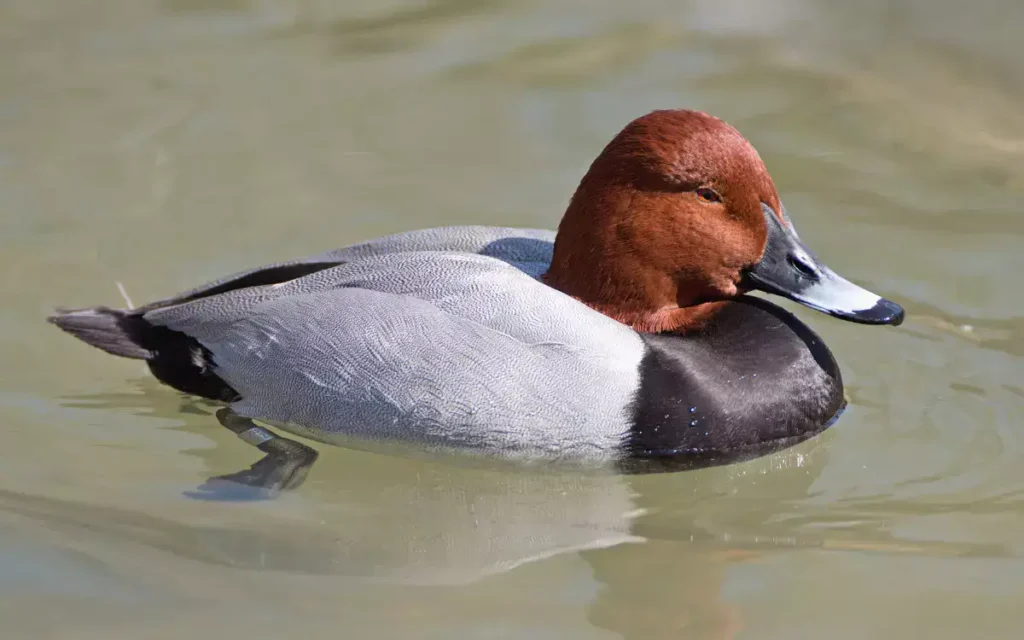
- Kingdom: Animalia
- Phylum: Chordata
- Class: Aves
- Order: Anseriformes
- Family: Anatidae
- Genus: Aythya
- Species: Aythya americana
Redheads are medium-sized ducks with males featuring a bright red head and black breast, and females are mottled brown. They are typically found in marshes and large lakes.Redheads are seasonal migrants, traveling to the northern parts of North America for breeding and moving south for the winter.
They mainly eat aquatic plants but also consume mollusks and insects during the breeding season.They nest in dense marsh vegetation, often borrowing the nests of other ducks.A female usually lays 7 to 14 eggs per season.The lifespan of Redheads in the wild is typically around 5 to 8 years, though survival rates can vary greatly due to environmental factors.
- Length: 16.9-20.9 in (43-53 cm)
- Weight: 1.5-3.2 lb (680-1450 g)
- Wingspan: 31-33 in (79-84 cm)
8. Ring-necked Duck – (Aythya collaris)
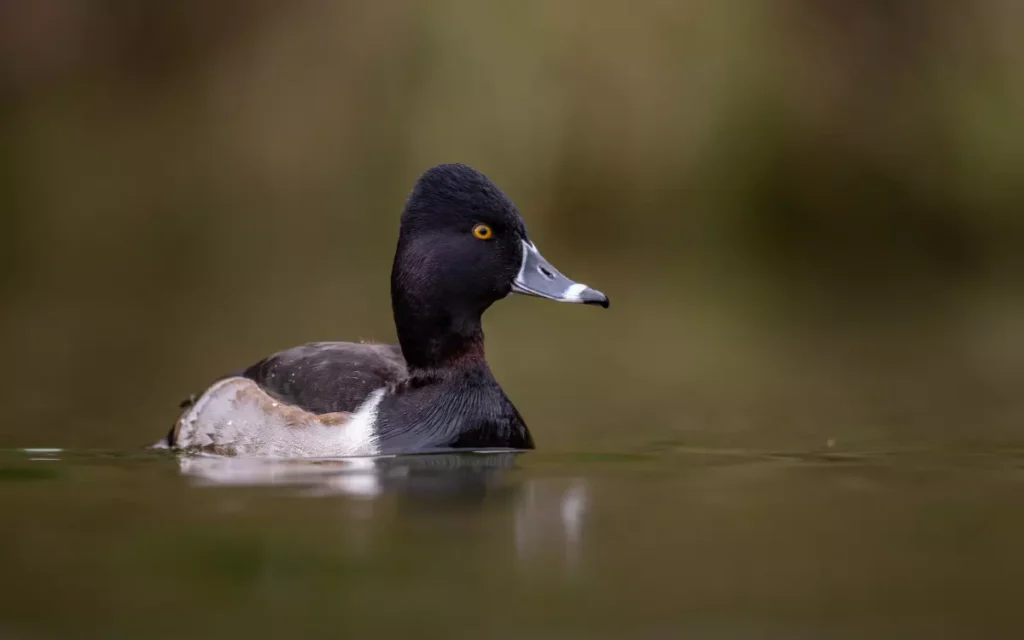
- Kingdom: Animalia
- Phylum: Chordata
- Class: Aves
- Order: Anseriformes
- Family: Anatidae
- Genus: Aythya
- Species: Aythya collaris
Ring-necked Ducks are small to medium-sized with males having black backs, white sides, and a subtle brown ring around their necks not easily seen at a distance. Females are mottled brown with a lighter face. They frequent small ponds and lakes.
They are migratory, spending summers in northern forests across North America and winters in the southern U.S. and Central America.Their diet includes aquatic vegetation and small fish.
They build nests near water among dense vegetation.Females lay about 8 to 10 eggs per breeding season.The typical lifespan in the wild is about 5 to 7 years, though this can vary based on environmental factors.
- Length: 15.3-18.1 in (39-46 cm)
- Weight: 17.3-32.1 oz (490-910 g)
- Wingspan: 24.4-24.8 in (62-63 cm)
9. American Coot – (Fulica americana)
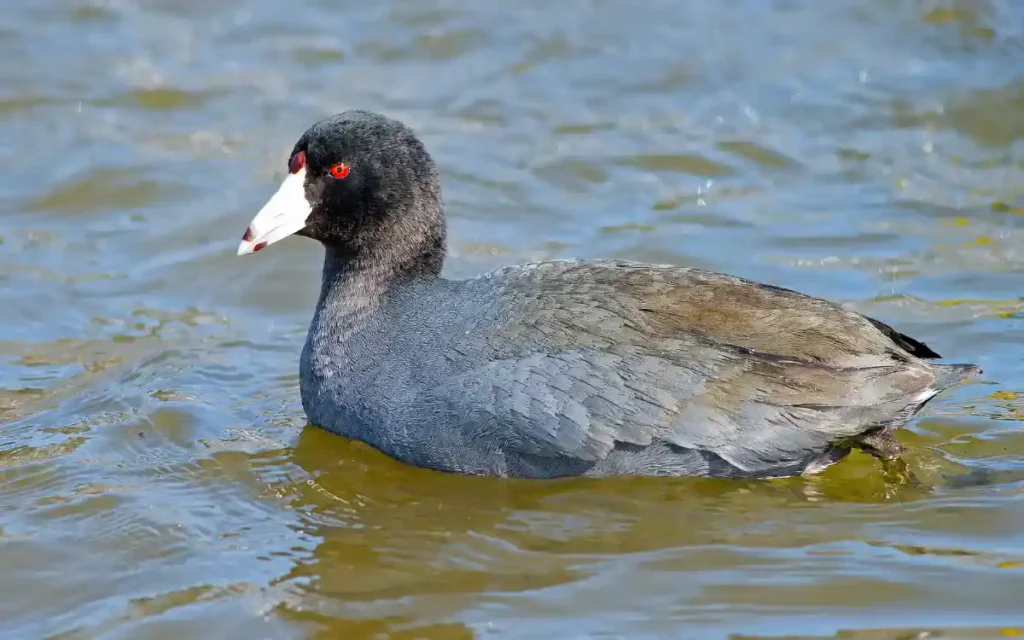
- Kingdom: Animalia
- Phylum: Chordata
- Class: Aves
- Order: Gruiformes
- Family: Rallidae
- Genus: Fulica
- Species: Fulica americana
American Coots are unique waterbirds with dark gray bodies and distinctive white bills. Unlike ducks, they have lobed toes rather than webbed feet and are often seen in freshwater ponds and lakes.These birds are partially migratory, with northern populations moving south for the winter, while others stay year-round in milder climates.
They eat aquatic plants, algae, and small aquatic animals like insects and fish.Coots build floating nests from plant material in sheltered waters.Females can lay between 8 to 12 eggs per breeding season.Their lifespan in the wild typically ranges from 8 to 10 years, though survival can vary widely due to environmental conditions.
- Length: 15.3 in (38.8 cm)
- Weight: 35.3 oz (1000 g)
- Wingspan: 23.6 in (60 cm)
Read also: 9 Geese & Swans Found In Louisiana
10. Greater Yellowlegs – (Tringa melanoleuca)
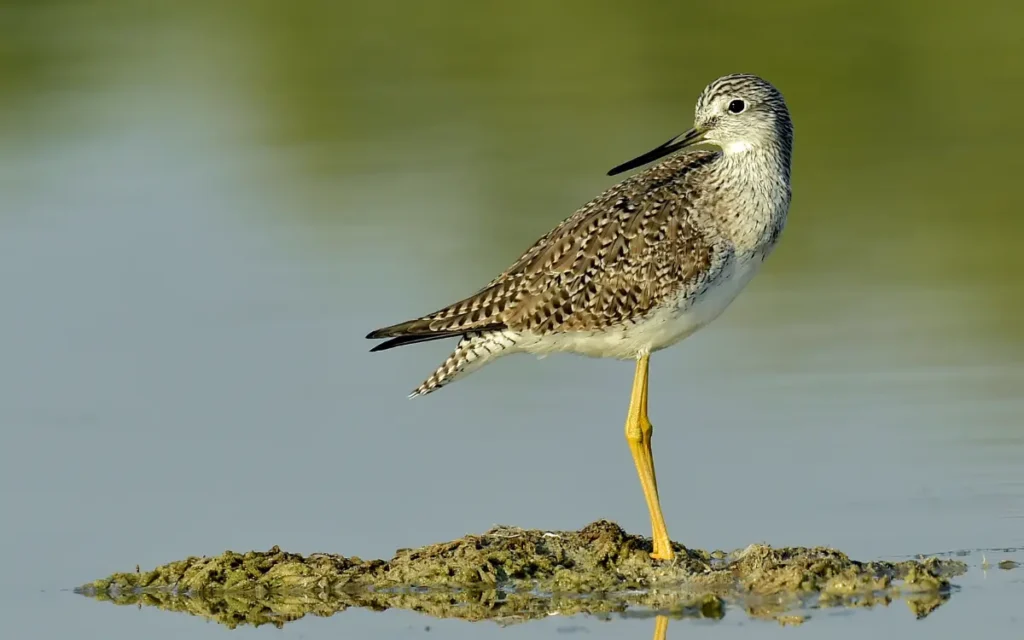
- Kingdom: Animalia
- Phylum: Chordata
- Class: Aves
- Order: Charadriiformes
- Family: Scolopacidae
- Genus: Tringa
- Species: Tringa melanoleuca
The Greater Yellowlegs is a medium-sized shorebird with a long, slender neck and bright yellow legs. Its body is grayish with white and gray streaking, and it has a sharp, upturned bill. Commonly found around wetlands and shorelines.
They are long-distance migrants, traveling from their breeding grounds in the subarctic regions of Canada to South America during the winter.Their diet consists of insects, small fish, and crustaceans, which they pick from shallow waters.
Nests are usually on the ground, hidden among vegetation in boreal forests.A typical clutch contains 4 eggs.While their average lifespan in the wild is less documented, shorebirds like the Greater Yellowlegs often live up to 10 years, depending on environmental conditions.
- Length: 13.8-15.8 in (35-40 cm)
- Weight: 6.0-10.6 oz (170-300 g)
- Wingspan: 22.1-26.8 in (56-68 cm)
11. Lesser Yellowlegs – (Tringa flavipes)
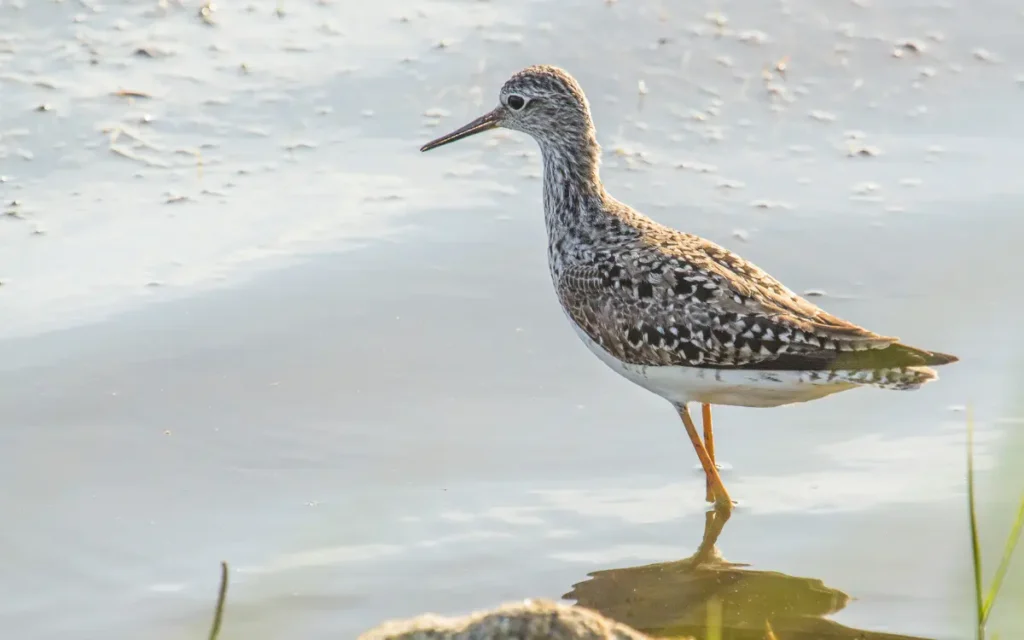
- Kingdom: Animalia
- Phylum: Chordata
- Class: Aves
- Order: Charadriiformes
- Family: Scolopacidae
- Genus: Tringa
- Species: Tringa flavipes
The Lesser Yellowlegs is a small shorebird with long, bright yellow legs and a light-gray body. It has a short, thin bill and is often seen in wetlands and along shores.They are amazing travelers, flying from northern Canada to South America each winter.
They eat tiny water creatures like insects and small fish.Their nests are simple, on the ground, usually hidden in grass near water.They lay about four eggs each spring.These birds can live up to 9 years, depending on their environment.
- Length: 9.8-11.0 in (25-28 cm)
- Weight: 2.9-3.2 oz (81-90 g)
- Wingspan: 18.9-20.5 in (48-52 cm)
12.Sandhill Crane – (Antigone canadensis)
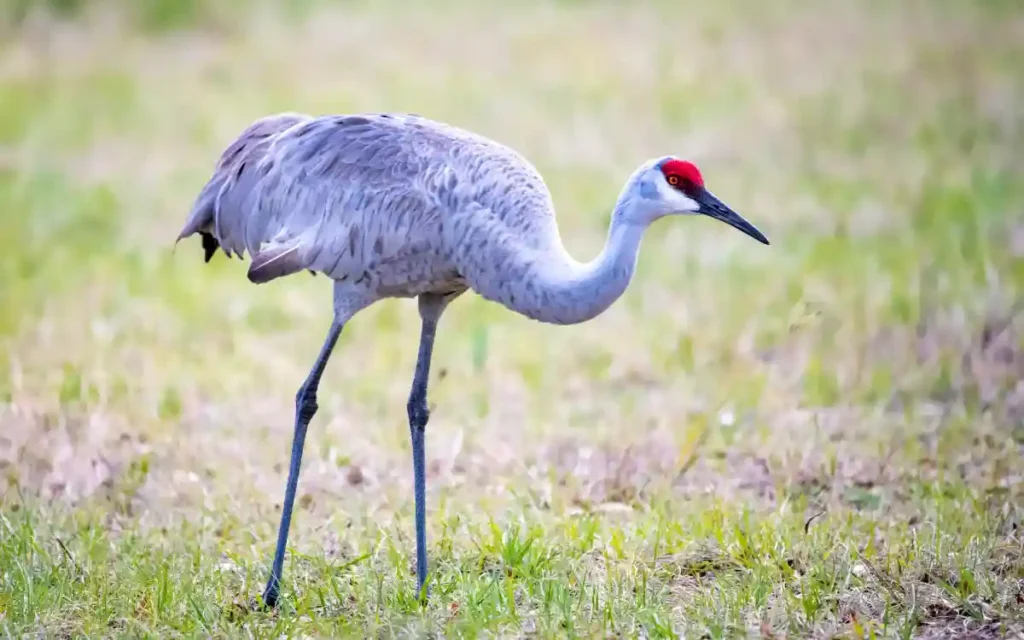
- Kingdom: Animalia
- Phylum: Chordata
- Class: Aves
- Order: Gruiformes
- Family: Gruidae
- Genus: Antigone
- Species: Antigone canadensis
Sandhill Cranes are tall, gray birds with a red forehead, white cheeks, and a long, dark bill. They stand out with their long necks and legs and can be seen in open fields and wetlands.These cranes are famous migrators, traveling great distances from their northern breeding grounds to winter in the southern U.S. and Mexico.
They eat a mix of plants and animals, including seeds, grains, insects, and small rodents.Their nests are large and made of plants, usually placed in shallow water.They typically lay two eggs each year.Sandhill Cranes can live up to 20 years in the wild, making them some of the longest-lived birds in their habitat.
- Length: 37-47 in (94-119 cm)
- Weight: 7.6-11 lb (3.46-5 kg)
- Wingspan: 63-79 in (160-200 cm)
13. Wilson’s Snipe – (Gallinago delicata)
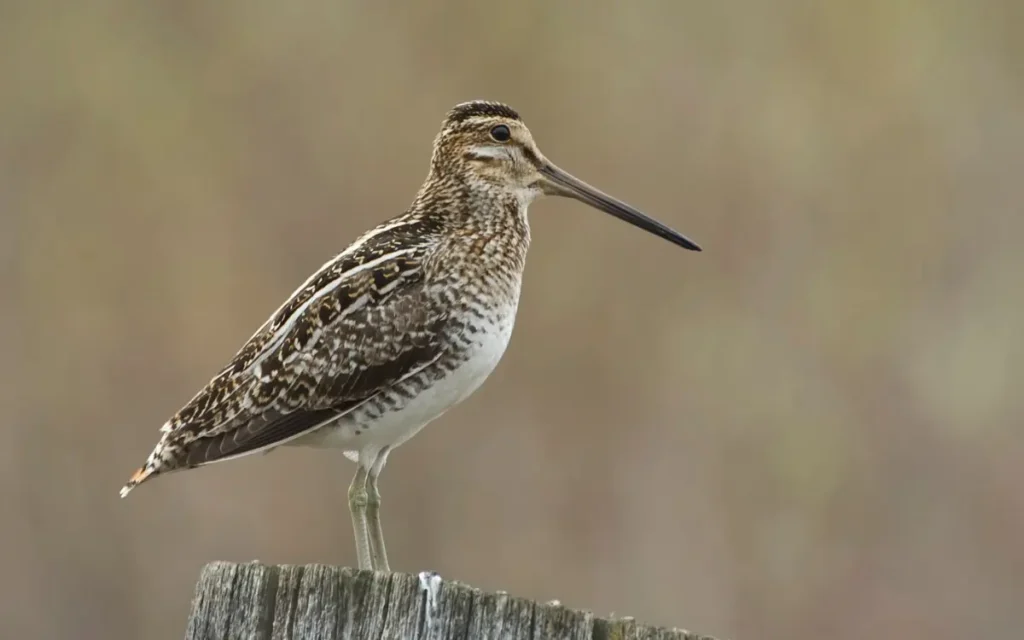
- Kingdom: Animalia
- Phylum: Chordata
- Class: Aves
- Order: Charadriiformes
- Family: Scolopacidae
- Genus: Gallinago
- Species: Gallinago delicata
The Wilson’s Snipe is a small bird that’s great at hiding. It has a long, straight beak and a brown-striped body, making it blend into marshy areas easily.Some of these birds fly south for the winter, but others stay put if the weather’s mild enough.
They love to eat bugs, worms, and small critters, which they find by poking their long beaks into mud.They make their nests on the ground, hidden among tall grasses.Each year, they lay about four eggs.A Wilson’s Snipe can live for up to 8 years in the wild.
- Length: 10.6-12.6 in (27-32 cm)
- Weight: 2.8-5.2 oz (79-146 g)
- Wingspan: 16.1-17.3 in (41-44 cm)
14. Bald Eagle – (Haliaeetus leucocephalus)
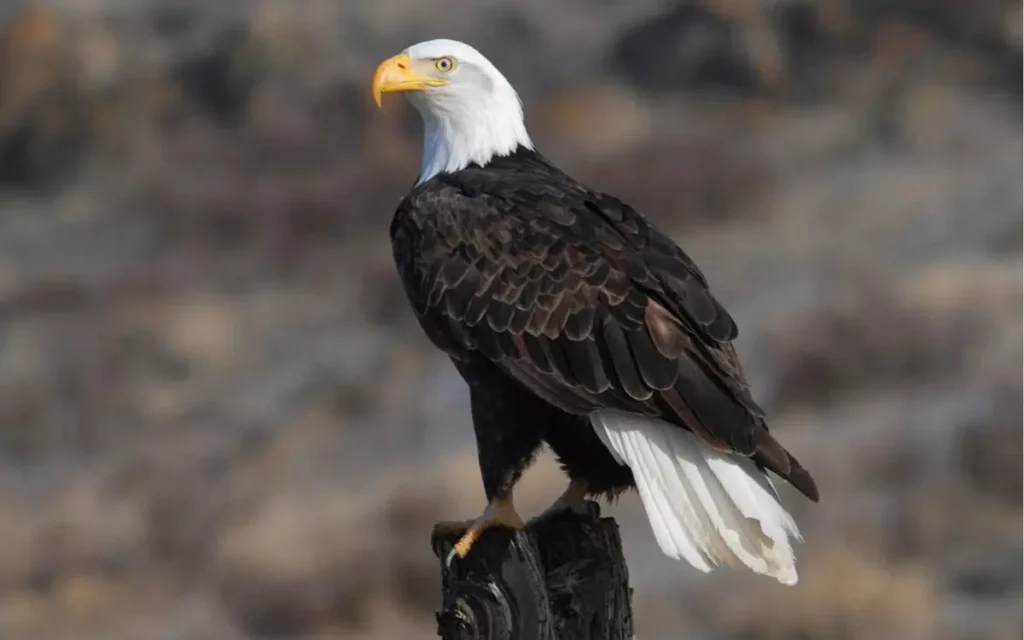
- Kingdom: Animalia
- Phylum: Chordata
- Class: Aves
- Order: Accipitriformes
- Family: Accipitridae
- Genus: Haliaeetus
- Species: Haliaeetus leucocephalus
The Bald Eagle is a big bird with a white head and tail, and a dark brown body. It’s famous for its strong yellow beak.These eagles don’t travel far unless they need to find more food or warmer places during very cold weather.
They love eating fish, which they grab with their sharp claws, but they’ll also eat small animals.They build huge nests high up in big trees or on cliffs and use the same nests each year.Every year, they lay about 1 to 3 eggs, usually just two.
- Length: 27.9-37.8 in (71-96 cm)
- Weight: 105.8-222.2 oz (3000-6300 g)
- Wingspan: 80.3 in (204 cm)
15. Red-tailed Hawk – (Buteo jamaicensis)
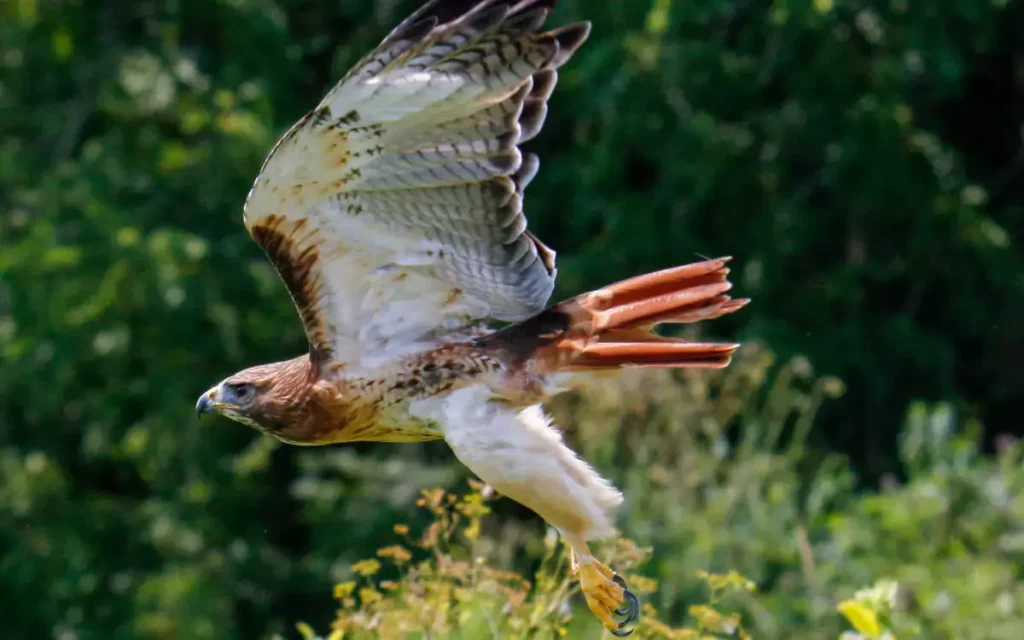
- Kingdom: Animalia
- Phylum: Chordata
- Class: Aves
- Order: Accipitriformes
- Family: Accipitridae
- Genus: Buteo
- Species: Buteo jamaicensis
The Red-tailed Hawk is a large bird with a broad, rounded wingspan and a characteristic red tail. Its body is mostly brown on top and white below, with a streaked belly.These hawks are mostly stay-at-home birds, though northern birds may move south for winter.
They are skilled hunters, eating mostly small mammals like mice and rabbits, as well as birds and snakes.They build nests in high places like trees or cliffs using sticks and vegetation.Annually, they lay two to four eggs.
- Length: 17.7-25.6 in (45-65 cm)
- Weight: 24.3-51.5 oz (690-1460 g)
- Wingspan: 44.9-52.4 in (114-133 cm)
16. American Kestrel – (Falco sparverius)
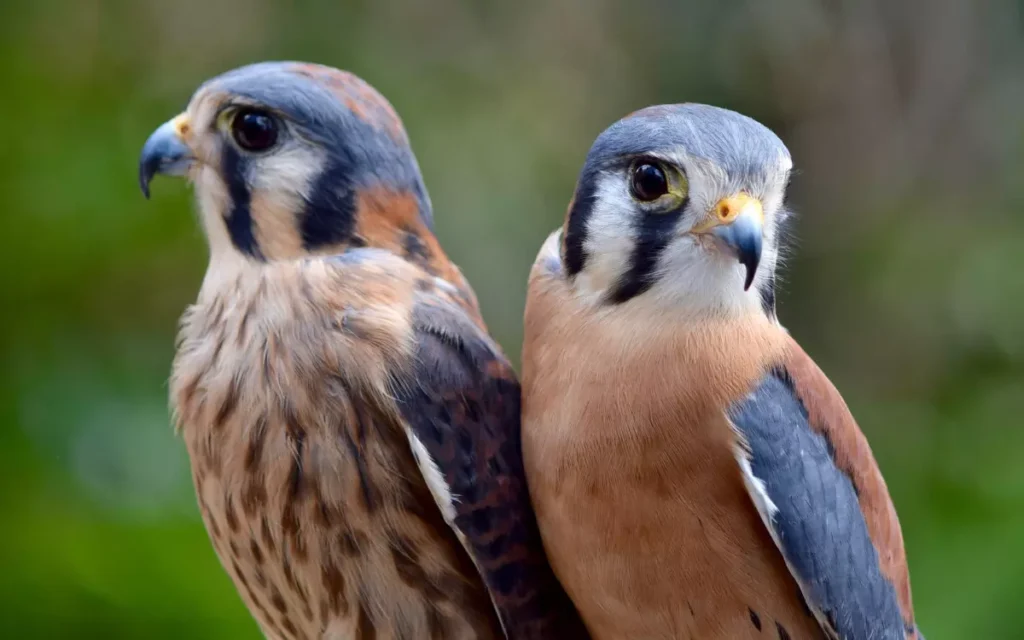
- Kingdom: Animalia
- Phylum: Chordata
- Class: Aves
- Order: Falconiformes
- Family: Falconidae
- Genus: Falco
- Species: Falco sparverius
The American Kestrel is the smallest falcon in North America. It has a colorful plumage with a slate-blue head and wings in males and brown-striped wings in females. Both genders have a distinctive double black mustache on the face.
These kestrels are partially migratory, depending on their location in North America; northern populations may move south in the winter.They hunt during the day, feeding on insects, small mammals, and birds by diving down from a perch.Kestrels nest in cavities in trees, cliffs, and buildings, often using old woodpecker holes.They lay 3 to 5 eggs per year.
- Length: 8.7-12.2 in (22-31 cm)
- Weight: 2.8-5.8 oz (80-165 g)
- Wingspan: 20.1-24.0 in (51-61 cm)
17. Northern Harrier – (Circus hudsonius)
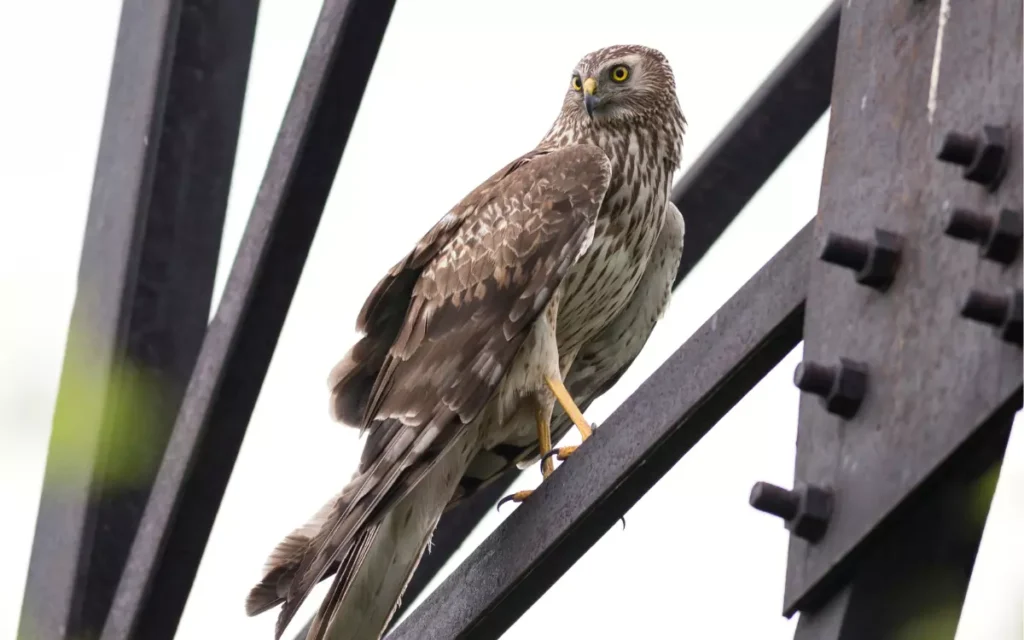
- Kingdom: Animalia
- Phylum: Chordata
- Class: Aves
- Order: Accipitriformes
- Family: Accipitridae
- Genus: Circus
- Species: Circus hudsonius
The Northern Harrier is a medium-sized hawk known for its long, slender wings and tail. It has a white rump patch that’s visible in flight. Males are gray while females and juveniles are brown.These birds are migratory, with many flying south for the winter, although some might stay in milder climates.
Northern Harriers glide low over fields to hunt for small mammals, birds, and insects.They build their nests on the ground in dense vegetation, making them hard to spot.They typically lay 4 to 5 eggs each breeding season.
- Length: 16.1-20.5 in (41-52 cm)
- Weight: 10.6-26.5 oz (300-750 g)
- Wingspan: 38.2-48 in (97-122 cm)
18. Ring-billed Gull – (Larus delawarensis)
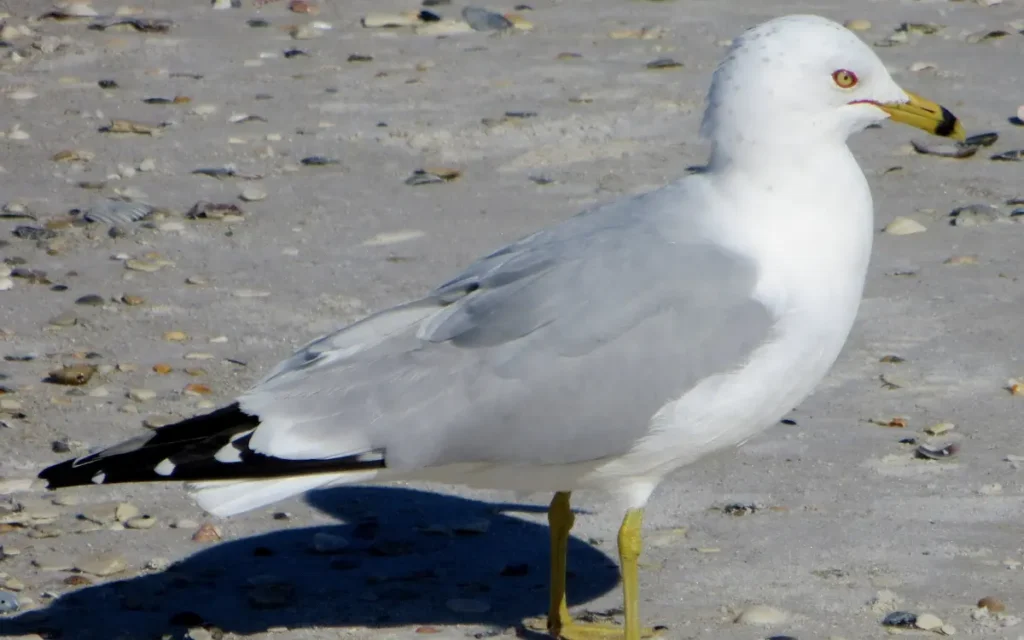
- Kingdom: Animalia
- Phylum: Chordata
- Class: Aves
- Order: Charadriiformes
- Family: Laridae
- Genus: Larus
- Species: Larus delawarensis
Description: The Ring-billed Gull is easily recognized by its medium size and the distinctive black ring around its yellow bill. It has a white body, gray wings, and yellow legs.These gulls are partially migratory, with populations in colder areas moving south for the winter, while others remain in the same area year-round if open water is available.
They eat a wide variety of foods, including fish, insects, and human-made scraps, often seen scavenging in parking lots and beaches.Ring-billed Gulls nest in colonies on the ground, using vegetation and debris to form nests.They typically lay 2 to 4 eggs each breeding season.
- Length: 16.9-21.3 in (43-54 cm)
- Weight: 10.6-24.7 oz (300-700 g)
- Wingspan: 41.3-46.1 in (105-117 cm)
19. Herring Gull – (Larus argentatus)
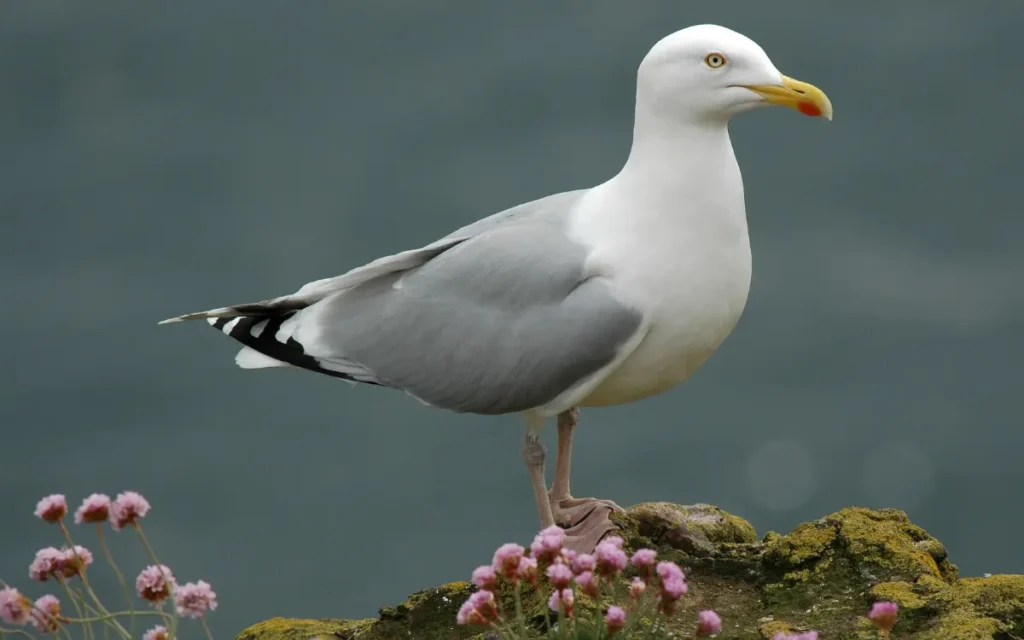
- Kingdom: Animalia
- Phylum: Chordata
- Class: Aves
- Order: Charadriiformes
- Family: Laridae
- Genus: Larus
- Species: Larus argentatus
The Herring Gull is a big bird with a white body and gray back, and you can spot it by the black tips on its wings. It has a yellow bill with a red spot which helps identify it.These gulls often move from cold places to warmer coastal areas during winter but some stay put all year if the place suits them.
They are not picky eaters, munching on fish, insects, and leftovers from people, and you might see them at beaches or even in cities.They build their nests on the ground in big groups, using grass and bits they find around.Every year, they usually lay 2 to 3 eggs.
- Length: 20-26 in (51-66 cm)
- Weight: 2.3-3.6 lb (1.04-1.65 kg)
- Wingspan: 47.2-61 in (120-155 cm)
20. Laughing Gull – (Leucophaeus atricilla)
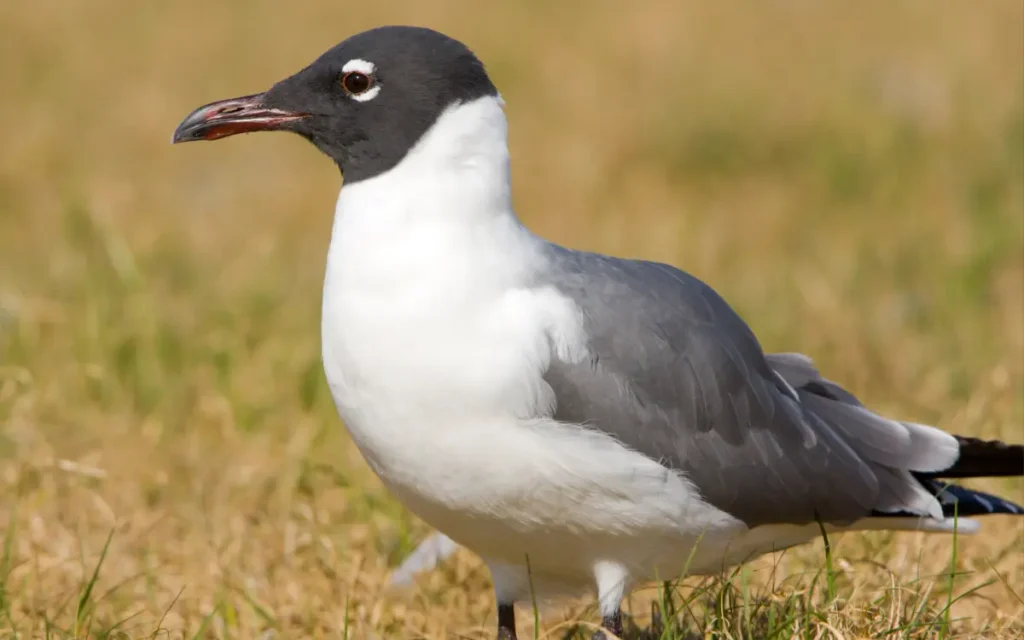
- Kingdom: Animalia
- Phylum: Chordata
- Class: Aves
- Order: Charadriiformes
- Family: Laridae
- Genus: Leucophaeus
- Species: Leucophaeus atricilla
The Laughing Gull is a medium-sized gull with a black head in the summer, gray wings, and a white underbelly. Known for its loud laugh-like call, this bird is a common sight along the coasts. They migrate south during winter, seeking warmer climates.
Laughing Gulls mainly eat fish, insects, and leftovers from humans. They nest on the ground in colonies, and each year, they lay up to three eggs. These birds are adaptable and can be seen following boats to grab scraps.
- Length: 14-16 in (36-41 cm)
- Weight: 9.8 oz (275-280 g)
- Wingspan: 39-43 in (98-110 cm)
21. Northern Cardinal – (Cardinalis cardinalis)
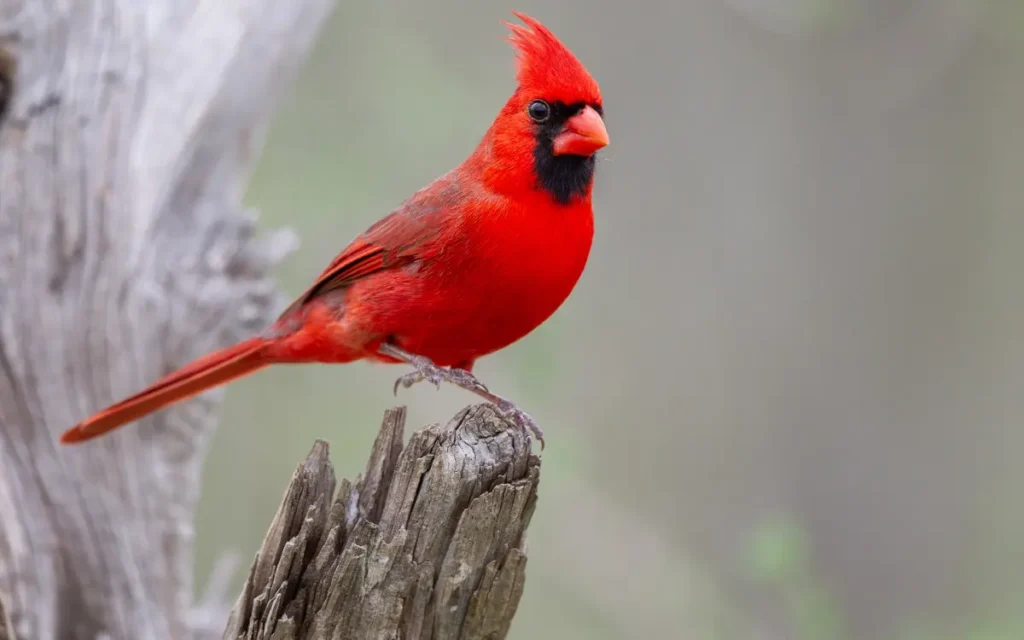
- Kingdom: Animalia
- Phylum: Chordata
- Class: Aves
- Order: Passeriformes
- Family: Cardinalidae
- Genus: Cardinalis
- Species: Cardinalis cardinalis
The Northern Cardinal is a striking bird with males sporting bright red feathers and females a more subdued brown with hints of red. These birds don’t migrate, staying in their home range year-round. Cardinals eat seeds, grains, and insects.
They build their nests in thick shrubs or trees, where the female lays three to four eggs each year. Known for their beautiful singing, cardinals are a favorite among bird watchers.
- Length: 8.3-9.4 in (21-24 cm)
- Weight: 1.5-1.7 oz (42-48 g)
- Wingspan: 9.8-12.2 in (25-31 cm)
22. American Goldfinch – (Spinus tristis)
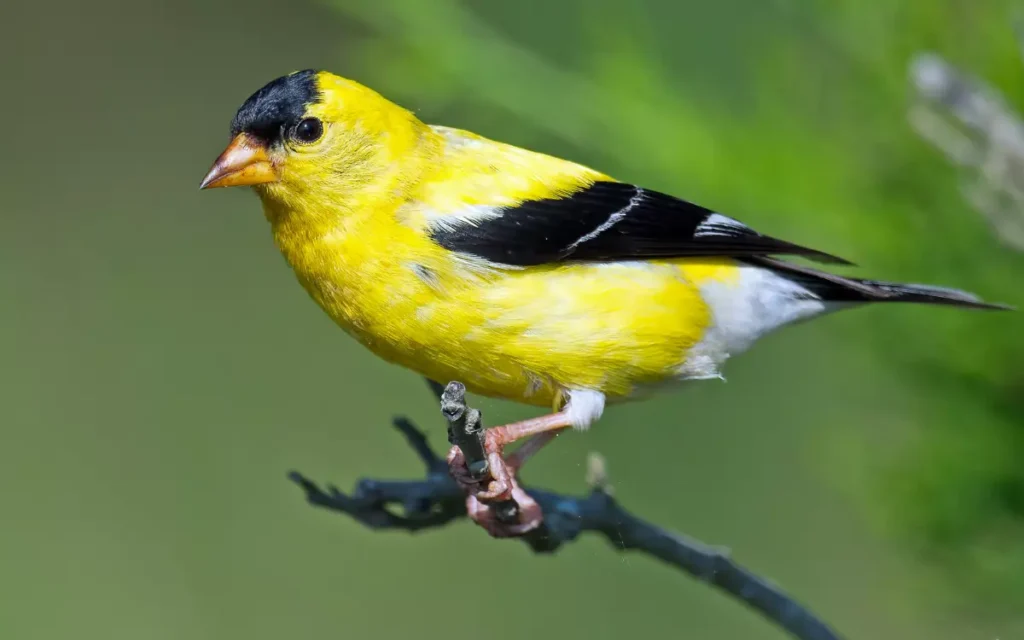
- Kingdom: Animalia
- Phylum: Chordata
- Class: Aves
- Order: Passeriformes
- Family: Fringillidae
- Genus: Spinus
- Species: Spinus tristis
The American Goldfinch is known for its vibrant yellow feathers in summer and olive-brown in winter. They migrate depending on the weather, traveling south if it gets too cold. Goldfinches love to eat seeds, especially from thistles and sunflowers.
They build their nests high in trees, weaving them tightly with plant materials. Each year, a female goldfinch lays about four to six eggs. These cheerful birds are often seen in flocks, fluttering acrobatically through the air.
- Length: 4.3-5.1 in (11-13 cm)
- Weight: 0.4-0.7 oz (11-20 g)
- Wingspan: 7.5-9 in (19-22 cm)
23. Eastern Bluebird – (Sialia sialis)
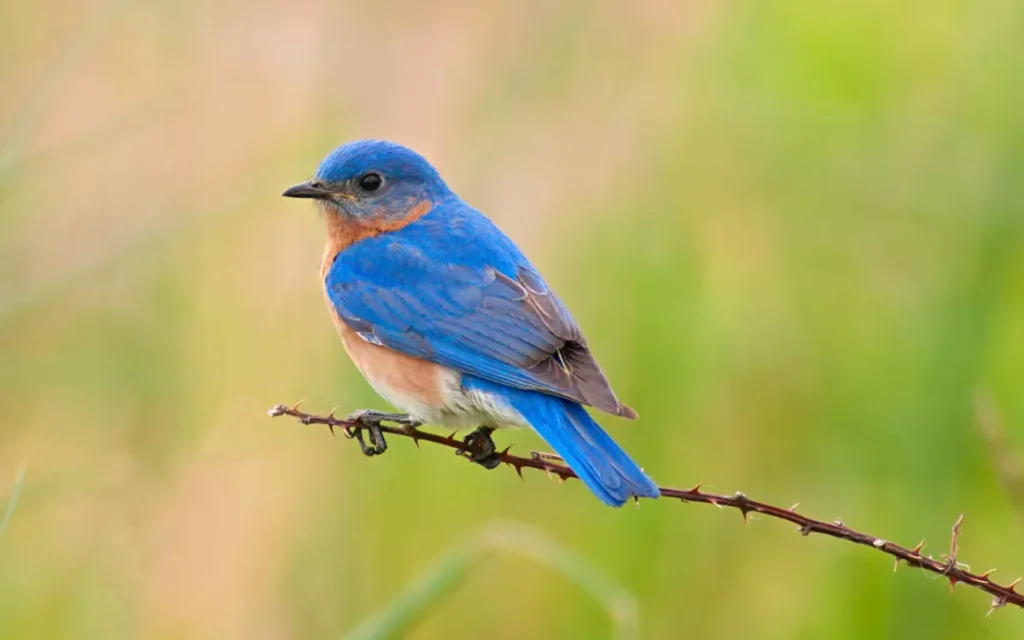
- Kingdom: Animalia
- Phylum: Chordata
- Class: Aves
- Order: Passeriformes
- Family: Turdidae
- Genus: Sialia
- Species: Sialia sialis
The Eastern Bluebird stands out with its bright blue feathers and rusty chest. These birds sometimes migrate south in the colder months, but many stay put if food is plentiful. They feast on insects and berries.
Eastern Bluebirds nest in tree cavities or nest boxes, making cozy homes. Each year, they can lay up to three clutches of eggs, with each clutch containing three to six eggs. These colorful birds are a delightful sight in open fields and gardens.
- Length: 6.3-8.3 in (16-21 cm)
- Weight: 1.0-1.1 oz (28-32 g)
- Wingspan: 9.8-12.6 in (25-32 cm)
24. Red-winged Blackbird – (Agelaius phoeniceus)
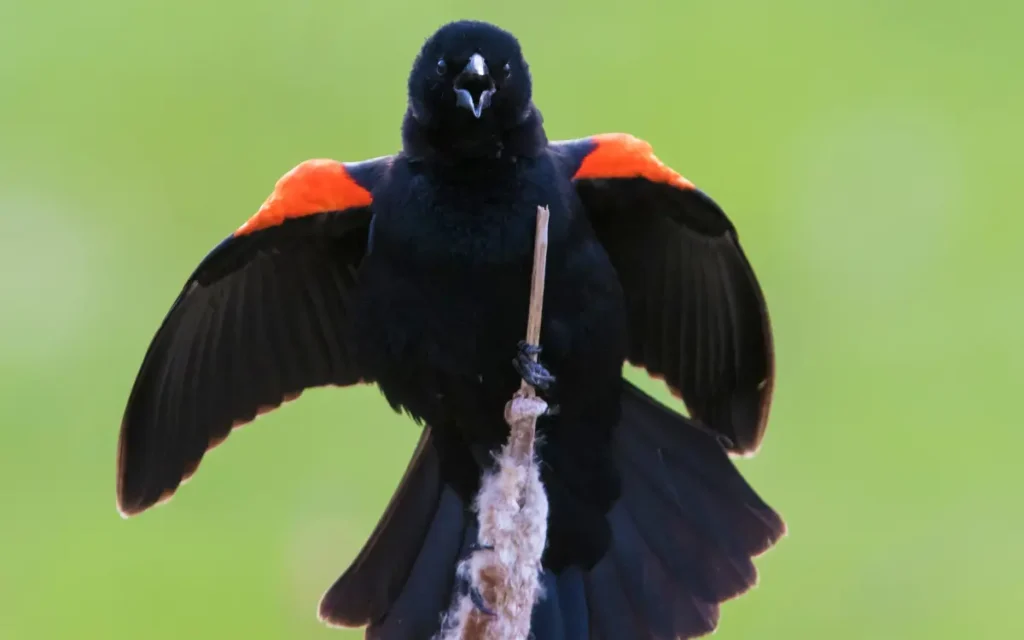
- Kingdom: Animalia
- Phylum: Chordata
- Class: Aves
- Order: Passeriformes
- Family: Icteridae
- Genus: Agelaius
- Species: Agelaius phoeniceus
The Red-winged Blackbird is easily recognized by the males’ black feathers and bright red and yellow shoulder patches. These birds migrate south for the winter. They eat insects, seeds, and grains. Red-winged Blackbirds nest in marshes and fields, weaving their nests from grasses and cattails.
Each year, the female lays three to four eggs. These birds are known for their distinctive calls and are often seen perched on reeds or fence posts.
- Length: 6.7-9.1 in (17-23 cm)
- Weight: 1.1-2.7 oz (32-77 g)
- Wingspan: 12.2-15.8 in (31-40 cm)
25.Song Sparrow – (Melospiza melodia)
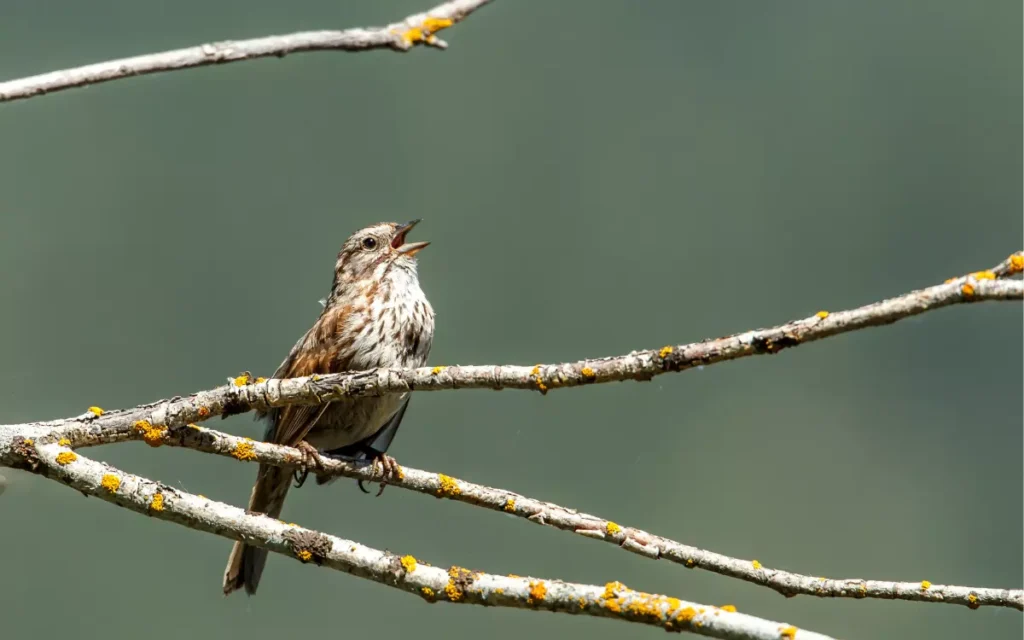
- Kingdom: Animalia
- Phylum: Chordata
- Class: Aves
- Order: Passeriformes
- Family: Passerellidae
- Genus: Melospiza
- Species: Melospiza melodia
The Song Sparrow has brown streaks on its white chest and a distinctive spot in the middle. These birds might migrate short distances in winter, but many stay year-round. They eat seeds, fruits, and insects. Song Sparrows build their nests on the ground or in low shrubs.
Each year, the female lays three to five eggs. Known for their melodious songs, these sparrows are often seen flitting through gardens and meadows, singing their cheerful tunes.
- Length: 4.7-6.7 in (12-17 cm)
- Weight: 0.4-1.9 oz (12-53 g)
- Wingspan: 7.1-9.4 in (18-24 cm)
26. Dark-eyed Junco – (Junco hyemalis)
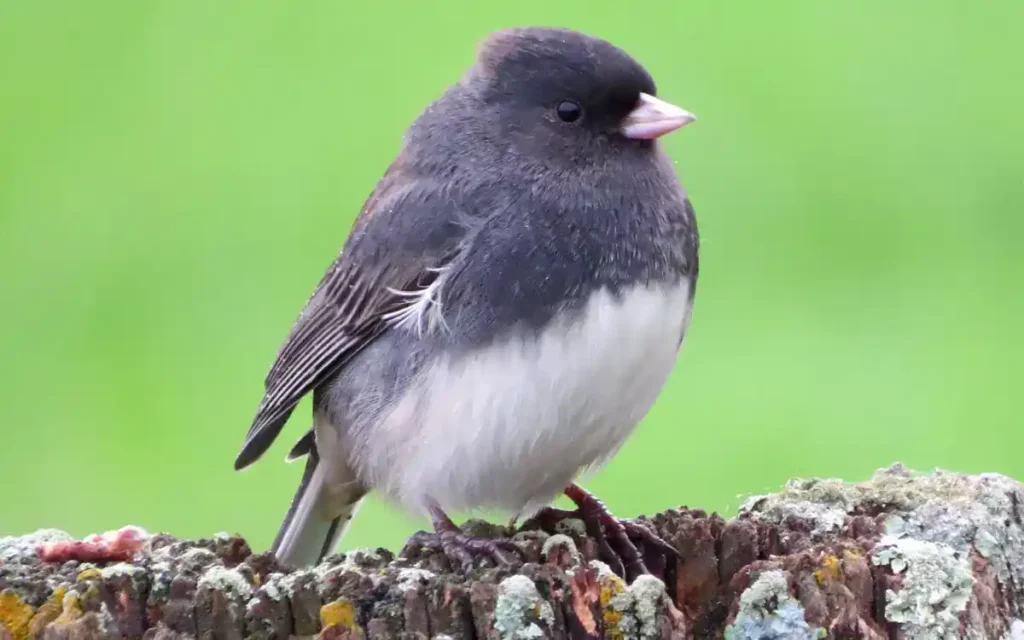
- Kingdom: Animalia
- Phylum: Chordata
- Class: Aves
- Order: Passeriformes
- Family: Passerellidae
- Genus: Junco
- Species: Junco hyemalis
The Dark-eyed Junco is a small bird with gray or brown feathers and a white belly. They migrate south during winter, returning north when it warms up. Juncos mainly eat seeds and insects. They nest on the ground or in low shrubs, using grass and leaves to build their nests.
Each year, a female junco lays three to five eggs. These birds are often seen hopping on the ground, searching for food, and are known for their pleasant, twittering calls.
- Length: 5.5-6.3 in (14-16 cm)
- Weight: 0.6-1.1 oz (18-30 g)
- Wingspan: 7.1-9.8 in (18-25 cm)
27. Carolina Chickadee – (Poecile carolinensis)
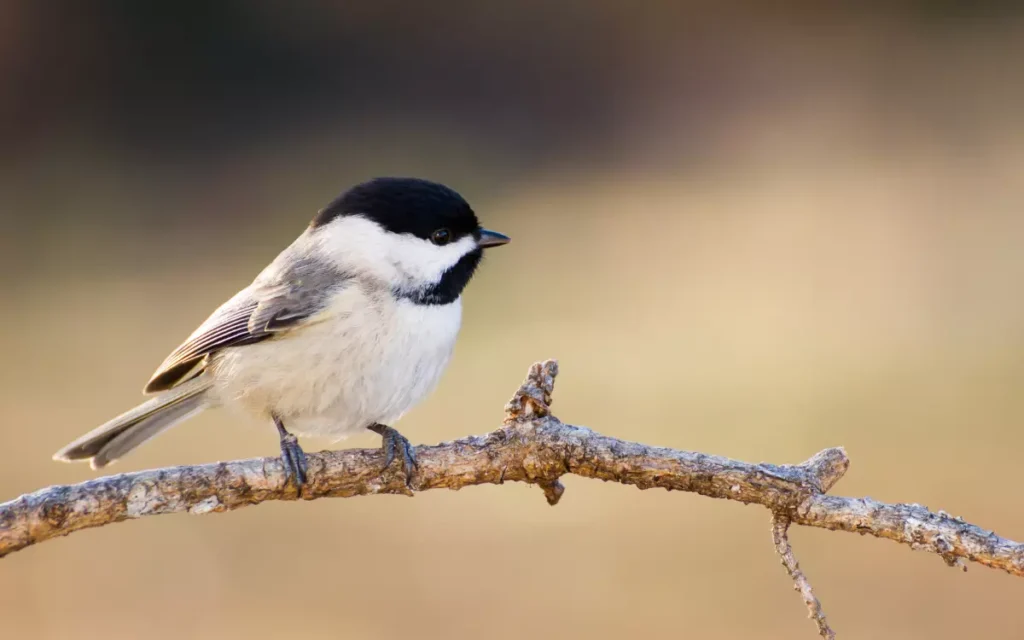
- Kingdom: Animalia
- Phylum: Chordata
- Class: Aves
- Order: Passeriformes
- Family: Paridae
- Genus: Poecile
- Species: Poecile carolinensis
The Carolina Chickadee is a tiny bird with a black cap, white cheeks, and gray wings. They do not migrate, staying in the same area year-round. These chickadees eat insects, seeds, and berries.
They nest in tree cavities or nest boxes, lining their nests with soft materials like moss and fur. Each year, a female chickadee lays five to eight eggs. These energetic birds are known for their cheerful “chick-a-dee-dee-dee” call and frequent visits to backyard feeders.
- Length: 4.5-5.1 in (11.5-13 cm)
- Weight: 0.32-0.42 oz (9-12 g)
- Wingspan: 5.9-7.9 in (15-20 cm)
28. Tufted Titmouse – (Baeolophus bicolor)
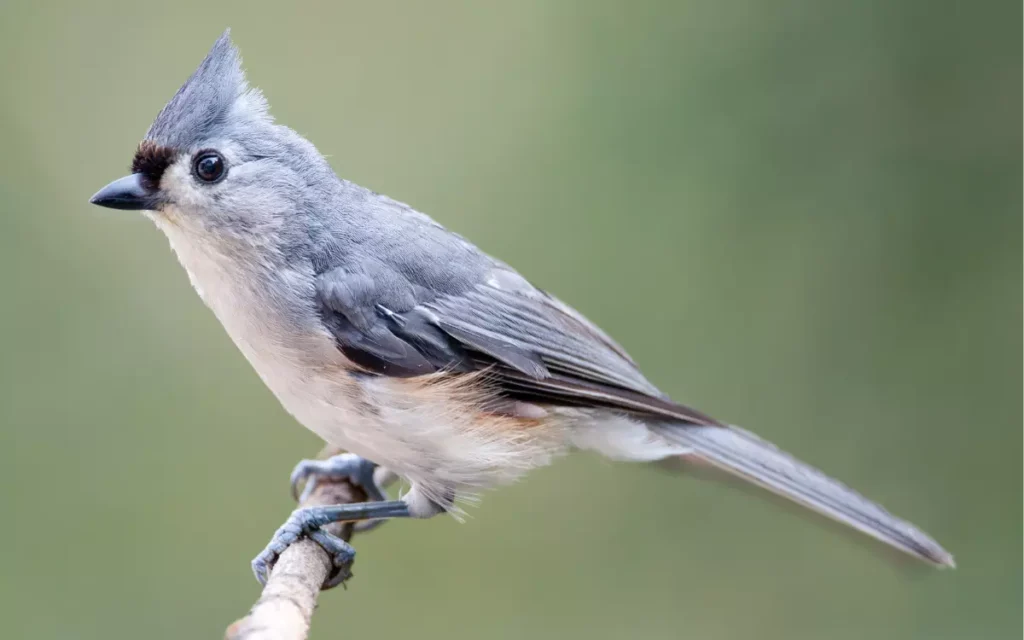
- Kingdom: Animalia
- Phylum: Chordata
- Class: Aves
- Order: Passeriformes
- Family: Paridae
- Genus: Baeolophus
- Species: Baeolophus bicolor
The Tufted Titmouse is a small bird with gray feathers, a white belly, and a distinctive crest on its head. They do not migrate, staying in their home range all year. Titmice eat seeds, insects, and berries. They nest in tree cavities or nest boxes, using soft materials like moss and fur.
Each year, a female titmouse lays five to six eggs. These lively birds are known for their loud, clear whistles and frequent visits to backyard feeders.
- Length: 5.5-6.3 in (14-16 cm)
- Weight: 0.6-0.9 oz (18-26 g)
- Wingspan: 7.9-10.2 in (20-26 cm)
29. Great Horned Owl – (Bubo virginianus)
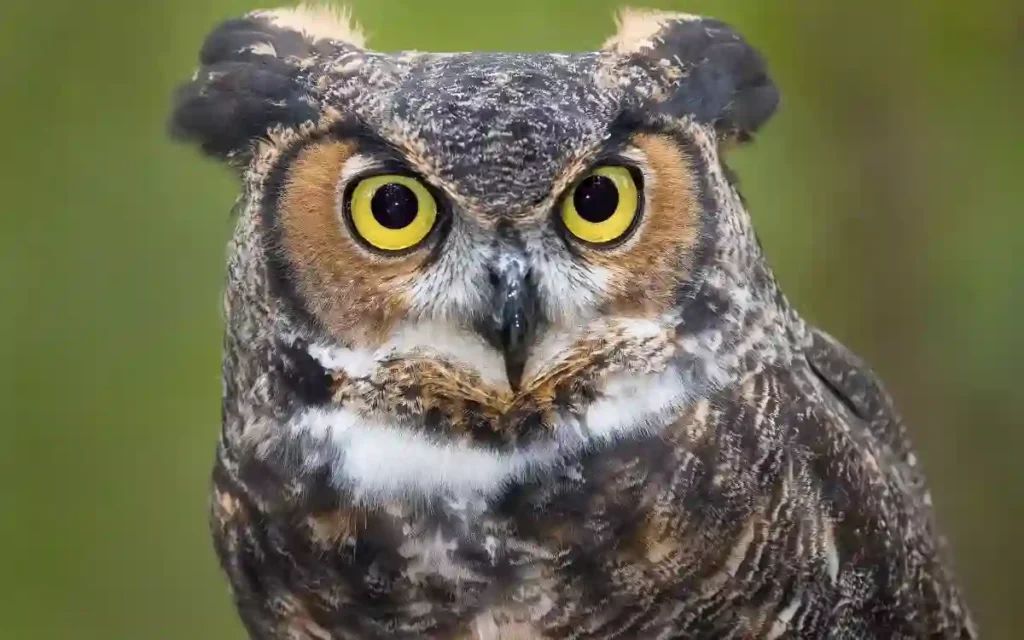
- Kingdom: Animalia
- Phylum: Chordata
- Class: Aves
- Order: Strigiformes
- Family: Strigidae
- Genus: Bubo
- Species: Bubo virginianus
The Great Horned Owl is a large owl with ear-like tufts of feathers on its head and striking yellow eyes. These owls do not migrate, staying in their territory year-round. They hunt at night, eating small mammals, birds, and reptiles. Great Horned Owls nest in trees, often using old nests from other birds.
Each year, the female lays one to three eggs. Known for their deep hooting calls, these powerful owls are top predators in their habitats.
- Length: 16.9-25.2 in (43-64 cm)
- Weight: 2-5.5 lb (0.9-2.5 kg)
- Wingspan: 35.8-59.8 in (91-152 cm)
30. Eastern Screech-Owl – (Megascops asio)
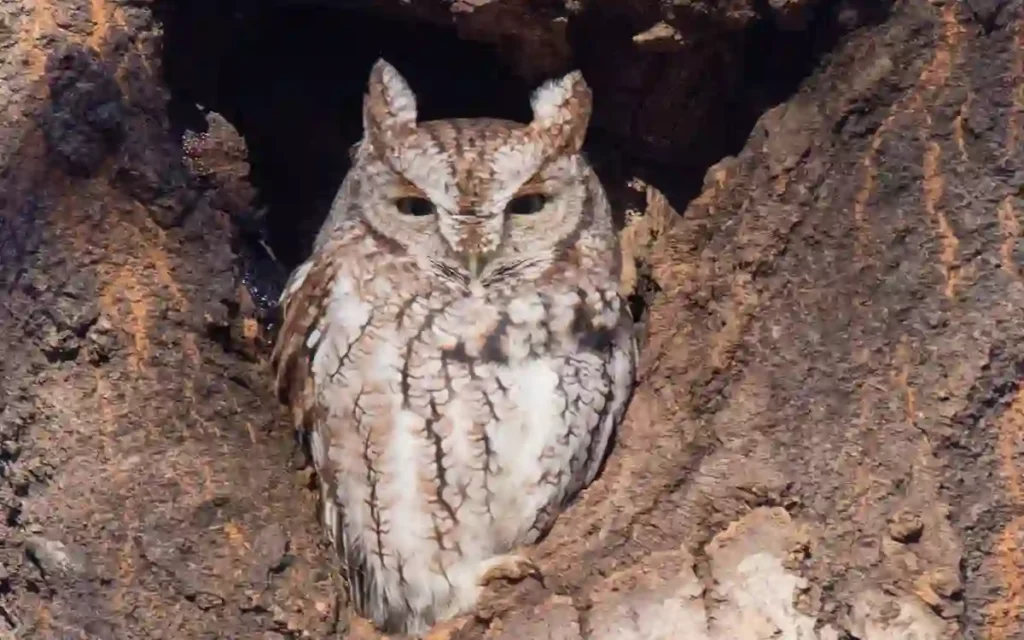
- Kingdom: Animalia
- Phylum: Chordata
- Class: Aves
- Order: Strigiformes
- Family: Strigidae
- Genus: Megascops
- Species: Megascops asio
The Eastern Screech-Owl is a small owl with gray or reddish-brown feathers and yellow eyes. These owls do not migrate, staying in their home range year-round. They hunt at night, eating insects, small mammals, and birds. Eastern screech owls nest in tree cavities or nest boxes.
Each year, the female lays three to five eggs. Known for their trilling and whinnying calls, these owls are well-camouflaged and blend in perfectly with tree bark.
- Length: 6.3-9.8 in (16-25 cm)
- Weight: 4.3-8.6 oz (121-244 g)
- Wingspan: 18.1-24 in (46-61 cm)
31. Barn Owl – (Tyto alba)
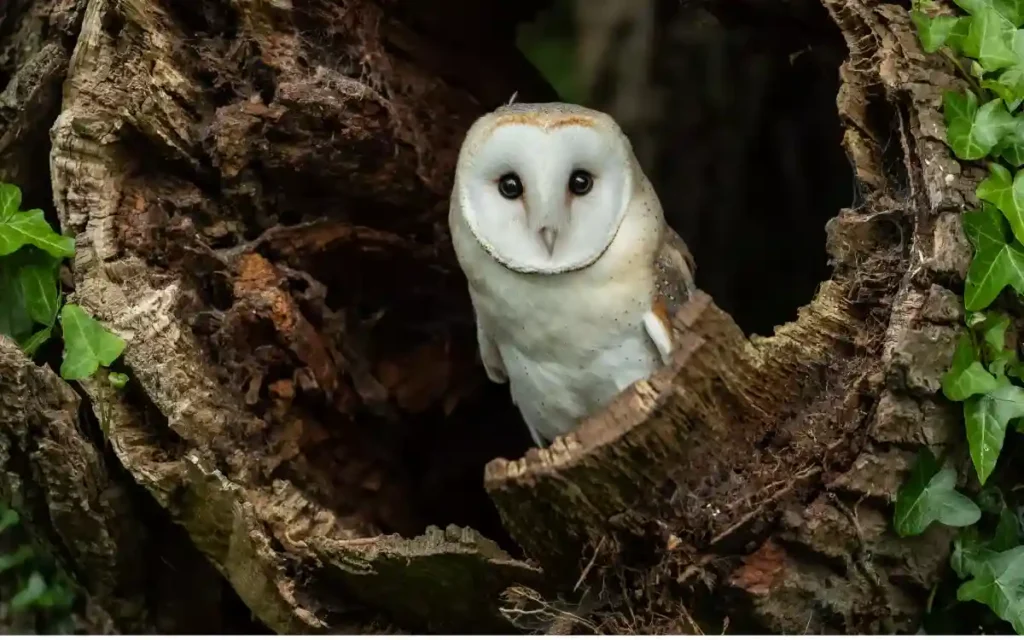
- Kingdom: Animalia
- Phylum: Chordata
- Class: Aves
- Order: Strigiformes
- Family: Tytonidae
- Genus: Tyto
- Species: Tyto alba
The Barn Owl has a heart-shaped face, white feathers on the face and belly, and golden-brown wings. These owls do not migrate, staying in the same area all year. They hunt at night, feeding mainly on small mammals like mice and rats.
Barn Owls nest in tree cavities, barns, or nest boxes. Each year, the female lays four to seven eggs. Known for their eerie screeching calls, these silent hunters have excellent hearing and night vision.
- Length: 12.6-15.75 in (32-40 cm)
- Weight: 0.55-1.26 lb (250-350 g)
- Wingspan: 31.5-43.3 in (80-110 cm)
Protecting Winter Birds in Louisiana:
In Louisiana, people are working hard to protect winter birds and their homes. They focus on saving wetlands and forests, which are important for birds. Restoring habitats by cleaning water and planting native plants helps too.
Educational programs teach everyone why birds matter and how to help. Birdwatching events also raise awareness. By taking care of natural places, Louisiana makes sure these birds have a safe place to live during the winter.
Winter Bird Watching place & Tips in Louisiana:
Louisiana is a great place to watch winter birds. Visit wetlands, forests, and parks to see a variety of birds. Good spots include Cameron Prairie National Wildlife Refuge and Atchafalaya Basin. Bring binoculars and a bird guide to help identify different species.
Wear warm clothes and go out early in the morning when birds are most active. Be quiet and patient to avoid scaring them away. Enjoy observing the beautiful winter birds in their natural habitats, including the 49 Red, Orange, and Yellow Birds in Louisiana.
FAQs
Q: What are some good places to watch winter birds in Louisiana?
A: Cameron Prairie National Wildlife Refuge and Atchafalaya Basin are great spots.
Q: What should I bring for birdwatching?
A: Bring binoculars, a bird guide, and wear warm clothes.
Q: When is the best time to watch birds?
A: Early morning is the best time when birds are most active.
Q: Why is Louisiana important for winter birds?
A: Louisiana provides diverse habitats essential for many bird species.
Q: How can I help conserve bird habitats in Louisiana?
A: Participate in local bird watching activities and support conservation programs.
Conclusion:
Louisiana is important for many winter birds, offering diverse habitats. Participating in local bird watching activities helps you appreciate and conserve these beautiful birds. Join in to support the amazing avian biodiversity in Louisiana and enjoy nature’s wonders.

